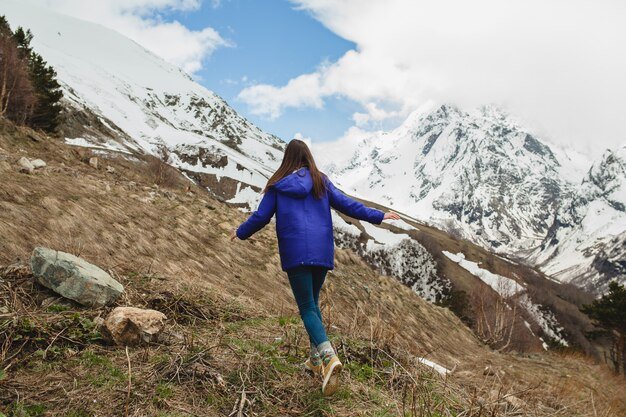The Annapurna Circuit Trek is celebrated not only for its challenging terrain but also for its stunning scenic spots that showcase the breathtaking beauty of the Himalayas. Among the myriad of remarkable locations along the route, five standout spots offer some of the most unforgettable views and experiences.
First on the list is Thorong La Pass, the highest point on the trek at 5,416 meters (17,769 feet). This high-altitude pass provides panoramic vistas of the Annapurna and Dhaulagiri ranges, with dramatic snow-capped peaks stretching as far as the eye can see. Standing at Thorong La Pass is a remarkable achievement, and the expansive views of the surrounding mountains are both awe-inspiring and rewarding. The sheer scale and beauty of the landscape here encapsulate the grandeur of the Himalayas.
Next, Manang Valley is a must-see for its stunning high-altitude beauty and unique cultural charm. Nestled at 3,500 meters (11,483 feet), the valley offers an enchanting mix of dramatic mountain scenery and traditional Tibetan-influenced culture. The serene, picturesque village of Manang is surrounded by towering peaks and is an excellent spot to acclimatize while taking in the majestic views. The valley’s alpine meadows and azure lakes, combined with its tranquil atmosphere, create a truly serene trekking experience.
Poon Hill, situated at an elevation of 3,210 meters (10,530 feet), is renowned for its spectacular sunrise views. An early morning hike to Poon Hill rewards trekkers with one of the most iconic panoramas in the Himalayas. As the sun rises, it bathes the Annapurna and Dhaulagiri ranges in golden light, illuminating the snow-covered peaks with a magical glow. The view from Poon Hill is a quintessential highlight of the trek, providing an unforgettable start to the day.
The Kali Gandaki Gorge is another extraordinary scenic spot, known for being one of the deepest gorges in the world. Carved by the Kali Gandaki River, the gorge offers dramatic and contrasting landscapes, from lush terraced fields and traditional villages in the lower regions to stark, arid landscapes higher up. The gorge’s impressive depth and the dynamic interplay of light and shadow create a visually striking environment that captures the rugged beauty of the region.
Lastly, Jomsom, a key town along the trek, is renowned for its stunning desert-like landscapes and striking mountain views. Located at an elevation of 2,700 meters (8,858 feet), Jomsom is a gateway to the Mustang region and offers sweeping views of the Nilgiri and Dhaulagiri peaks. The town’s unique setting amidst the barren, wind-swept terrain and its proximity to the high-altitude desert landscape provide a dramatic contrast to the lush areas of the trek.
These five scenic spots—Thorong La Pass, Manang Valley, Poon Hill, Kali Gandaki Gorge, and Jomsom—each offer distinct and awe-inspiring views that encapsulate the diverse beauty and grandeur of the Annapurna Circuit. Whether it’s the high-altitude vistas, cultural charm, or dramatic landscapes, these locations contribute to an unforgettable trekking experience.
Introduction
The Annapurna Circuit Itinerary is one of the most celebrated trekking routes in Nepal, renowned for its diverse landscapes, rich cultural experiences, and challenging terrain. This iconic trek circumnavigates the Annapurna Massif, offering trekkers a journey through a stunning variety of environments, from lush subtropical forests and terraced fields to high-altitude deserts and snowy peaks. The circuit provides a comprehensive Himalayan experience, showcasing the natural beauty and cultural richness of the Annapurna region. Spanning approximately 160 to 230 kilometers (100 to 145 miles), it takes trekkers through a series of unique ecosystems and traditional villages inhabited by various ethnic groups. Completing the Annapurna Circuit is not just a physical challenge but also a deep immersion into Nepal’s natural and cultural heritage, making it a memorable adventure for outdoor enthusiasts and culture seekers alike.
Overview of the Annapurna Circuit Trek
The Annapurna Circuit Trek is a legendary route that traverses the Annapurna range, offering trekkers an unparalleled experience of the Himalayas. Starting from Besisahar, the trek follows the Marsyangdi River, meandering through terraced fields and lush forests before reaching the high-altitude landscapes of the Tibetan Plateau. The highlight of the trek is crossing Thorong La Pass, the highest point at 5,416 meters (17,769 feet), which provides stunning panoramic views of the surrounding mountain ranges. After the pass, the trek descends through the Kali Gandaki Gorge, one of the world’s deepest gorges, and ends in Jomsom or another nearby town. The entire journey typically takes 15 to 20 days, depending on the pace and itinerary. Along the way, trekkers encounter traditional villages, ancient monasteries, and a variety of wildlife, making the Annapurna Circuit a comprehensive and enriching trekking experience.
Planning Your Trek
Planning your Annapurna Circuit trek requires careful consideration to ensure a successful and enjoyable adventure. Start by determining the duration of your trek, which typically ranges from 15 to 20 days. This allows for adequate acclimatization and exploration. Next, decide on the best time to trek; the pre-monsoon (March to May) and post-monsoon (September to November) seasons offer the most favorable weather conditions. Secure the necessary permits, including the Annapurna Conservation Area Permit (ACAP) and the Trekkers’ Information Management System (TIMS) card. Create a detailed itinerary, including rest days for acclimatization, and consider hiring a local guide or porter to enhance safety and support. Additionally, make arrangements for accommodation and food, as the trek passes through numerous teahouses and lodges. Preparing for potential challenges, such as altitude sickness and variable weather, is also crucial. Proper planning ensures a smoother and more rewarding trekking experience.
Best Time to Visit
Choosing the best time to visit the Annapurna Circuit Trek map is essential for a successful trekking experience. The optimal periods are the pre-monsoon (March to May) and post-monsoon (September to November) seasons. During these times, the weather is generally stable, offering clear skies, moderate temperatures, and minimal rainfall. The pre-monsoon season features warmer temperatures and blooming flora, enhancing the trek’s beauty. Conversely, the post-monsoon season provides crisp air and excellent visibility, ideal for panoramic mountain views. The monsoon season (June to August) brings heavy rains, which can make trails slippery, increase the risk of landslides, and limit visibility. Winter (December to February) presents cold temperatures and potential snow, especially at higher altitudes, which can make trekking conditions more challenging. Therefore, planning your trek during the recommended seasons maximizes comfort, safety, and enjoyment of the stunning Himalayan landscapes.
Gear and Equipment
Having the right gear and equipment is crucial for a successful Annapurna Circuit trek. Start with sturdy, well-fitting hiking boots that offer good ankle support and traction on varied terrain. Layering is key, so pack moisture-wicking base layers, insulating mid-layers such as fleece or down jackets, and a waterproof outer layer like a rain jacket and pants. A durable backpack with a rain cover, a comfortable sleeping bag rated for cold temperatures, and trekking poles are also essential. Don’t forget a headlamp or flashlight with extra batteries, a hat, gloves, and sunglasses with UV protection. A reliable water purification system, such as a filter or purification tablets, is necessary for safe drinking water. Also, include a first aid kit, personal medications, and sunblock. Using high-quality gear ensures comfort and safety throughout the trek, allowing you to fully enjoy the adventure and handle the challenges of the Annapurna Circuit effectively.
Thorong La Pass
Thorong La Pass is the highest point on the Annapurna Circuit, standing at 5,416 meters (17,769 feet) above sea level. This iconic pass is a significant milestone and offers one of the most breathtaking panoramic views in the Himalayas. From the summit, trekkers are rewarded with sweeping vistas of the Annapurna and Dhaulagiri ranges, a dramatic contrast of snow-covered peaks and deep blue skies. The journey to Thorong La involves challenging ascents and the risk of altitude sickness, making it a demanding part of the trek. However, the sense of accomplishment upon reaching the pass is immense. The pass is often covered in snow, and the stark, high-altitude environment contrasts sharply with the lush greenery found at lower elevations. The clear skies and crisp mountain air provide a spectacular backdrop for photographs and memories. The trek across Thorong La Pass is a highlight of the Annapurna Circuit, symbolizing both the physical and emotional triumph of completing this world-renowned trek.
Manang Valley
The Manang Valley is a high-altitude region located at around 3,500 meters (11,483 feet) and serves as a critical acclimatization stop on the Annapurna Circuit. This picturesque valley is surrounded by towering peaks and offers a blend of natural beauty and cultural richness. The valley’s serene atmosphere and stunning landscapes provide a much-needed respite for trekkers adjusting to the altitude. The village of Manang, with its traditional Tibetan architecture and local monasteries, adds a cultural dimension to the experience. Trekkers can explore the surrounding areas, including the scenic Gangapurna Lake and the dramatic Annapurna II and III peaks. The valley also features ancient monasteries, like the Braga Monastery, which are worth visiting for their historical and spiritual significance. Manang is an essential stop for acclimatization, and its tranquil environment and breathtaking views make it a memorable part of the Annapurna Circuit.
Poon Hill
Poon Hill, situated at an elevation of 3,210 meters (10,530 feet), is renowned for its spectacular sunrise views over the Annapurna and Dhaulagiri ranges. A pre-dawn hike to Poon Hill rewards trekkers with one of the most iconic panoramas in the Himalayas. As the sun rises, it bathes the snow-capped peaks in a golden light, creating a stunning visual display. The early morning trek to Poon Hill is relatively short but involves a steep climb, often made in the dark with the help of headlamps. Upon reaching the summit, trekkers can enjoy unobstructed views of the surrounding mountain ranges and the Himalayan landscape’s dramatic contrasts. Poon Hill is a popular spot for capturing stunning photographs of the sunrise and is a favorite for those looking to experience the grandeur of the Himalayas without the intensity of higher-altitude trekking.
Muktinath Temple
Muktinath Temple, located at an elevation of 3,710 meters (12,172 feet), is a sacred site for both Hindus and Buddhists and a significant cultural stop on the Annapurna Circuit Trek. This revered temple is dedicated to Lord Vishnu, one of Hinduism’s principal deities, and is considered a place of liberation and salvation. The temple is situated in a unique high-altitude setting, surrounded by a stark, arid landscape that contrasts with the lush greenery found in other parts of the trek. Pilgrims and trekkers alike visit Muktinath to perform religious rituals, bathe in the 108 water spouts that surround the temple, and experience the spiritual atmosphere. The site’s sacred significance, combined with its dramatic location and panoramic views of the surrounding mountains, makes it a notable destination on the Annapurna Circuit. Muktinath’s cultural and religious importance adds a profound dimension to the trek, enriching the overall experience.
Jharkot Village
Jharkot Village, situated at approximately 3,600 meters (11,811 feet), is a charming traditional settlement that offers a glimpse into the local culture and lifestyle of the Annapurna region. This village is located along the trail to Muktinath and serves as a peaceful stopover for trekkers. Jharkot is characterized by its well-preserved traditional architecture, including ancient stone houses and a historic monastery. The village’s setting, with its backdrop of arid, desert-like terrain and views of the snow-capped peaks, provides a stark contrast to the lush lower elevations. Visitors can explore the local monastery, which is an important cultural and religious site, and interact with the friendly locals who maintain traditional lifestyles. Jharkot’s unique blend of cultural heritage and scenic beauty makes it a memorable stop on the Annapurna Circuit, offering insight into the region’s rich history and traditions.


